Transform Your Outdoor Oasis: The Ultimate Guide to Home-Hearted Landscaping & Sustainable Garden Design
Imagine your outdoor spaces as a seamless extension of your home’s unique personality and comfort. Just as a well-appointed living room invites relaxation, thoughtful landscaping transforms your yard into a beautiful, functional, and deeply personal sanctuary. Whether you dream of a vibrant garden retreat, a dynamic area for entertaining, or an inviting entryway, landscaping empowers you to infuse the same care and creativity into your exterior as you do your interior.
At Home-Hearted, we believe that landscaping transcends mere plants and patios; it’s about crafting outdoor environments that truly resonate with your personal style and enhance your daily life. This comprehensive guide will walk you through essential tips, inspiring ideas, and the latest trends to help you plan and design a Home-Hearted Landscape that feels intrinsically like you. Whether you’re a passionate DIY enthusiast ready to dig in or prefer to collaborate with seasoned professionals, these insights are designed to bring a sense of calmness, joy, and enduring beauty to your landscaping journey.
Why Landscaping is Essential for Every Home
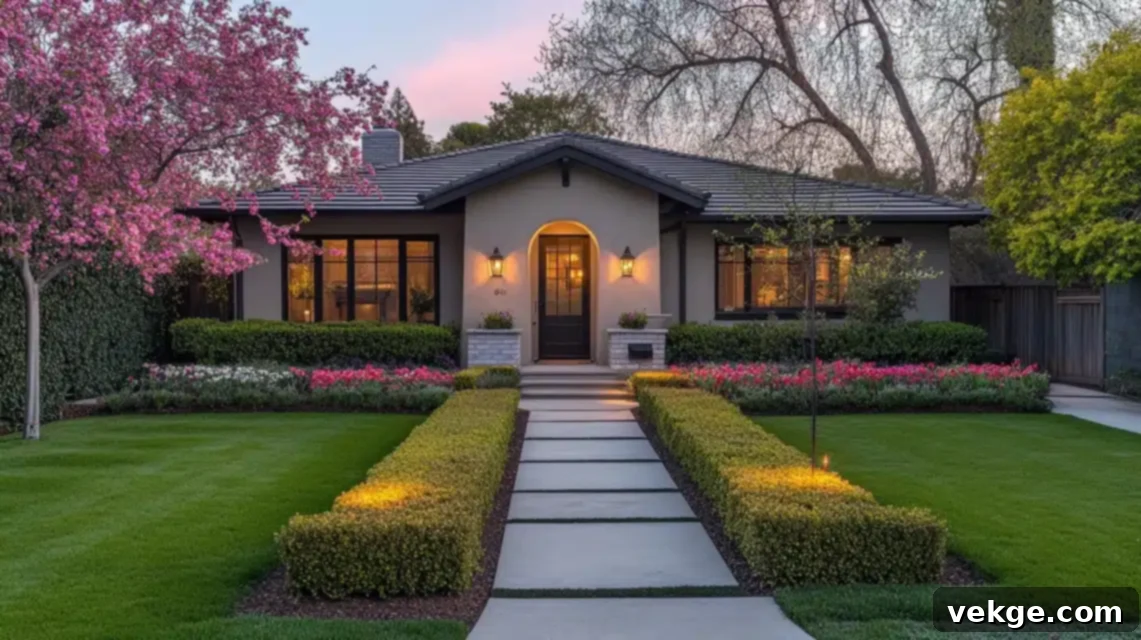
Consider your yard as your home’s initial greeting to the world, a canvas reflecting your inner space. As someone who has spent countless hours transforming outdoor environments, I can attest that landscaping is far more than just aesthetics; it’s about crafting a space that brings a smile to your face every time you arrive home.
1. Boosting Curb Appeal and First Impressions
Recall the last time you admired a home with meticulously trimmed hedges, vibrant flower beds, and a pristine lawn. That’s the undeniable impact of exceptional landscaping! Homes can be utterly transformed by seemingly simple changes. Adding layered flower beds that offer year-round blooms, strategically placed modern landscape lighting, and clear, inviting pathways to the front door can dramatically elevate a property’s curb appeal. A personal favorite trick for instant allure is planting graceful flowering trees like dogwoods or cherry blossoms near the entrance. They create a stunning, natural archway that gently guides the eye exactly where you want it – to your beautiful home.
2. Expanding Your Home’s Living Space Outdoors
Your backyard represents hundreds of square feet of untapped potential. I discovered this firsthand when I converted my basic lawn into a true outdoor living room, complete with a cozy seating area, ambient lighting, and a small, fragrant herb garden. Think about dividing your outdoor space into distinct “zones” to maximize its functionality and enjoyment:
- A Peaceful Reading Nook: Envision a comfortable pergola-covered area with weatherproof cushions and a small side table, perfect for your favorite beverage and a good book.
- An Inviting Outdoor Dining Area: Ideal for summer barbecues, enhanced with charming string lights and potted herbs nearby for fresh garnishes and aromas.
- A Kid-Friendly Play Zone: Design a play area that harmonizes with the natural landscape, perhaps using rubber mulch under equipment and surrounding it with hardy, child-safe plants.
- A Serene Meditation Garden: Incorporate a soothing small water feature for stress relief, enclosed by elegant ornamental grasses for privacy and gentle sound buffering.
3. Increasing Property Value Over Time
Here’s a vital insight: landscaping is one of the few home improvements that genuinely appreciates in value over time. While interior design trends fluctuate, mature trees and well-established gardens only grow more magnificent with age. Smart landscaping investments that consistently yield excellent returns include:
- Installing a High-Efficiency Irrigation System: Essential for maintaining lush greenery while reducing water waste through smart scheduling and zone control.
- Planting Strategic Shade Trees: Positioning deciduous trees on the south and west sides of your home can significantly reduce energy costs. My utility bills saw a remarkable 20% drop after my maples reached maturity!
- Adding Privacy Landscaping: Utilizing evergreen shrubs like arborvitae or holly creates natural, beautiful boundaries that often surpass traditional fences in aesthetic appeal and ecological benefit.
- Developing Low-Maintenance, Drought-Resistant Gardens: These designs are highly attractive to prospective buyers, offering both visual appeal and reduced monthly upkeep costs.
Ultimately, the secret to a successful landscape lies in a well-conceived plan that considers both your immediate enjoyment and the long-term benefits it will bring to your home and lifestyle.
Your DIY Landscaping Journey: Getting Started with Confidence
Embarking on a landscaping project can feel overwhelming, especially when faced with a blank canvas. I recall staring at my own bare yard, wondering, “Where on earth do I even begin?” But here’s the crucial secret I’ve learned: successful landscaping is all about starting small, embracing manageable projects, and building confidence with each step you take. Let me share some practical, personal tips that have helped me transform outdoor spaces efficiently, without breaking the bank or feeling overwhelmed.
1. The Power of Starting Small for Quick Wins
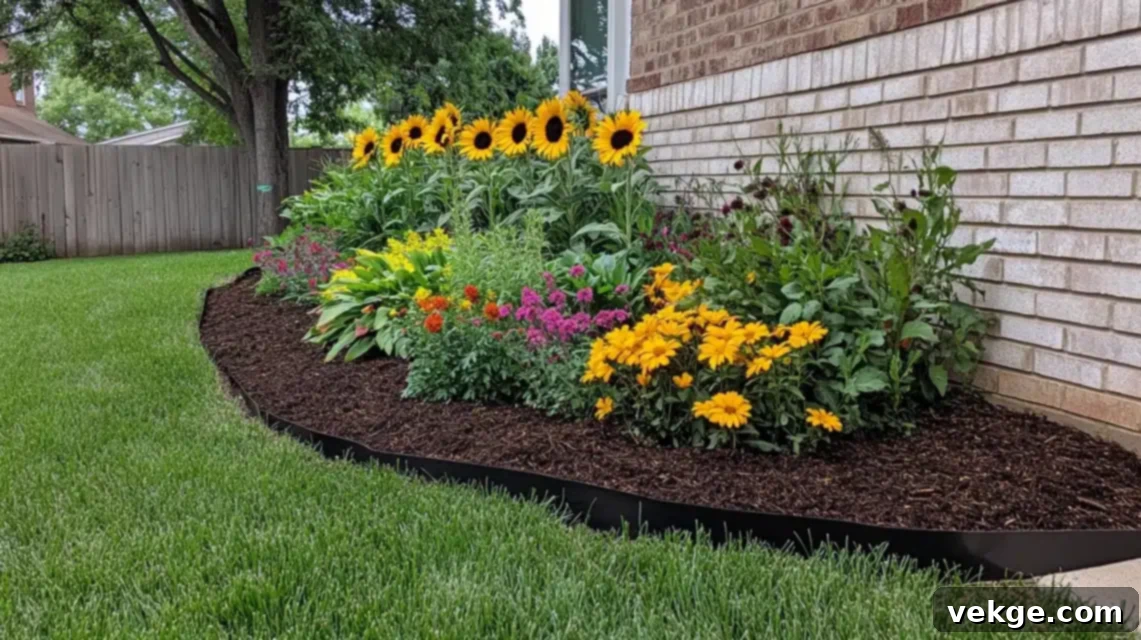
The most effective way to begin your landscaping adventure is with projects that offer quick, visible results. When I first started, I focused on transforming one small corner of my yard at a time. Before I knew it, the entire space had undergone a remarkable change. A perfect starting point is a simple flower bed near your entrance – it’s astonishing what a 4×8 foot area can achieve. My preferred beginner method involves laying cardboard over the existing grass to naturally suppress weeds, then adding a layer of quality topsoil, and finally planting 2-3 types of flowers you genuinely adore. Remember the “thriller, filler, spiller” rule for container gardens and small beds: a tall “thriller” plant in the back for drama, medium-height “filler” plants in the middle, and cascading “spiller” plants along the front edges.
Mastering the art of mulching is another excellent foundational skill. While it may seem mundane, the benefits are immense. Mulch not only suppresses weeds and retains soil moisture but also adds a polished, professional finish. To calculate your needs, remember that one cubic yard of mulch covers approximately 100 square feet at a depth of 3 inches. Apply mulch when the soil is moist but not saturated, keeping it 2-3 inches away from plant stems and tree trunks, and aim for a consistent depth of 2-4 inches for optimal weed control and moisture retention.
2. Budget-Friendly Landscaping Hacks
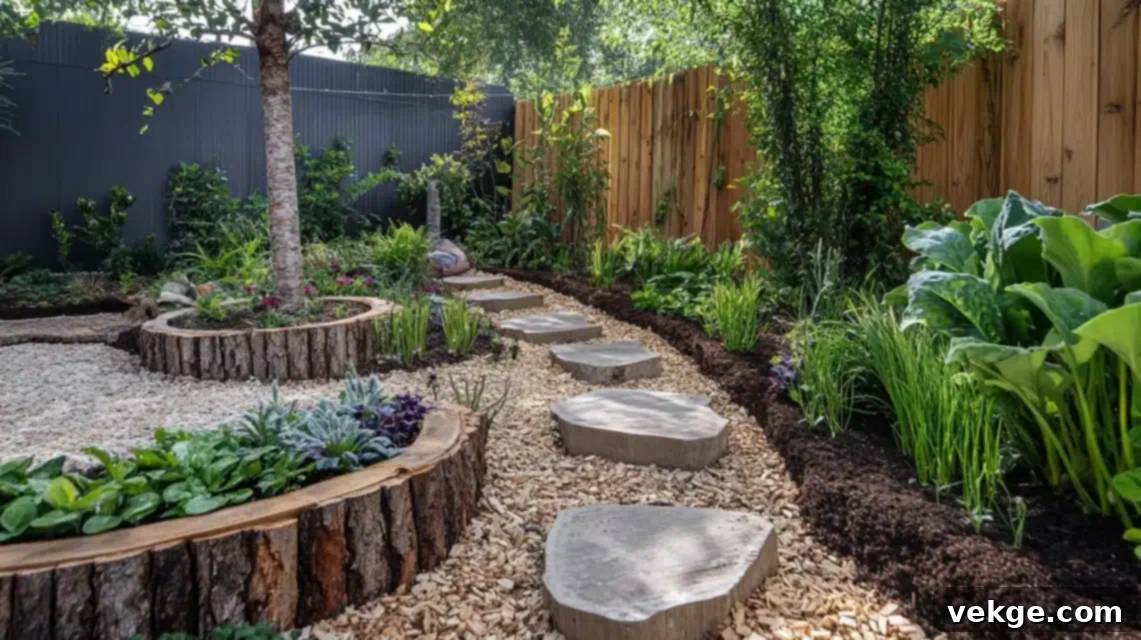
Creating a stunning landscape doesn’t require a hefty budget. Many of my most successful projects have stemmed from creative thinking and resourcefulness. Here are some ways to save money and get creative:
Clever Material Repurposing Ideas:
- Transform fallen tree branches into rustic, natural garden borders.
- Utilize broken concrete pieces, often called “urbanite,” for unique and durable stepping stones.
- Repurpose old wooden pallets into innovative vertical gardens, perfect for herbs or strawberries.
- Convert empty wine bottles into decorative and functional garden bed edging.
Smart Plant Choices for Savings:
- Divide existing perennial plants to fill new spaces, effectively getting free plants.
- Engage in plant swaps with neighbors – a fantastic way to acquire new varieties at no cost (I built my entire hosta collection this way!).
- Prioritize native plants that naturally thrive in your local climate, requiring less water and fewer interventions.
- Start plants from seeds or cuttings, a highly economical method for growing many species.
DIY Pathway Solutions for Every Budget:
- Create attractive, eco-friendly paths using free wood chips often available from local tree services.
- Fashion custom stepping stones using simple concrete forms for a personalized touch.
- Edge your pathways with bricks found on online marketplaces or reclaimed from demolition sites.
- Utilize crushed granite for an affordable, durable, and permeable pathway surface.
3. Seasonal Maintenance for Year-Round Beauty

The secret to a consistently gorgeous landscape lies in understanding seasonal needs and proactive care:
- Spring (March-May): Focus on a thorough clean-up of winter debris. Prune any dead or damaged branches, apply pre-emergent weed control when soil temperatures consistently reach 55°F, and define your garden beds with fresh edging. This is also the ideal time to add new mulch and divide overgrown perennials before their vigorous new growth begins.
- Summer (June-August): Proper watering is key – aim for deep, infrequent irrigation (approximately 1-1.5 inches per week) to encourage deep root growth. Consistently deadhead flowering plants to promote continuous blooming and mow your lawn at a higher setting (3-4 inches) to protect roots and suppress weeds. Conduct weekly checks for any emerging pest issues.
- Fall (September-November): Critical for setting up a healthy garden for the next year. Plant spring-blooming bulbs, as well as new trees and shrubs. Clean up fallen leaves (shred them for excellent free mulch!), and protect tender plants from the first frosts. Gradually reduce watering as temperatures drop and plants enter dormancy.
- Winter (December-February): Once the ground freezes, apply a layer of winter mulch to protect plant roots. Shield evergreens from harsh winter burns with burlap, especially if exposed to strong winds or intense sun. After snowstorms, check for any damage to branches, and utilize this quieter season to meticulously plan next year’s gardening projects – it’s a surprisingly enjoyable winter activity!
Remember, gardening success is a journey of progress, not a quest for unattainable perfection. Every “mistake” is, in fact, a valuable learning opportunity—and believe me, I’ve had my share! Start with these fundamental steps, and don’t hesitate to experiment as your confidence grows. And always, always take plenty of “before” pictures. You’ll be truly amazed at the transformation when you reflect on where you began.
Pro Tips for Laying a Strong Landscaping Foundation
- Start with a Soil Test: Understanding your soil’s composition and pH levels is crucial for selecting plants that will truly thrive in your specific yard.
- Embrace Your Local Climate: Choose native plants specifically adapted to your region; they require less water, fertilizer, and pest control, making maintenance significantly easier.
- Think Year-Round Interest: Design your landscape with a mix of evergreens for winter structure and seasonal bloomers to ensure visual appeal in every season.
- Prioritize Outdoor Lighting: Thoughtful lighting extends your enjoyment of outdoor spaces well into the evening, enhances safety, and creates a magical ambiance.
- Plan Your Irrigation Early: Installing or upgrading an irrigation system is far simpler and more effective before your plants and hardscaping are fully established.
Diverse Landscaping Ideas for Every Home and Style
In my journey of transforming countless outdoor spaces, I’ve consistently found that the most impactful landscaping ideas beautifully balance aesthetic appeal with practical functionality. Let’s explore some proven design concepts adaptable to any home, regardless of its size, architectural style, or your personal preferences.
1. Crafting an Inviting Front Yard Landscape
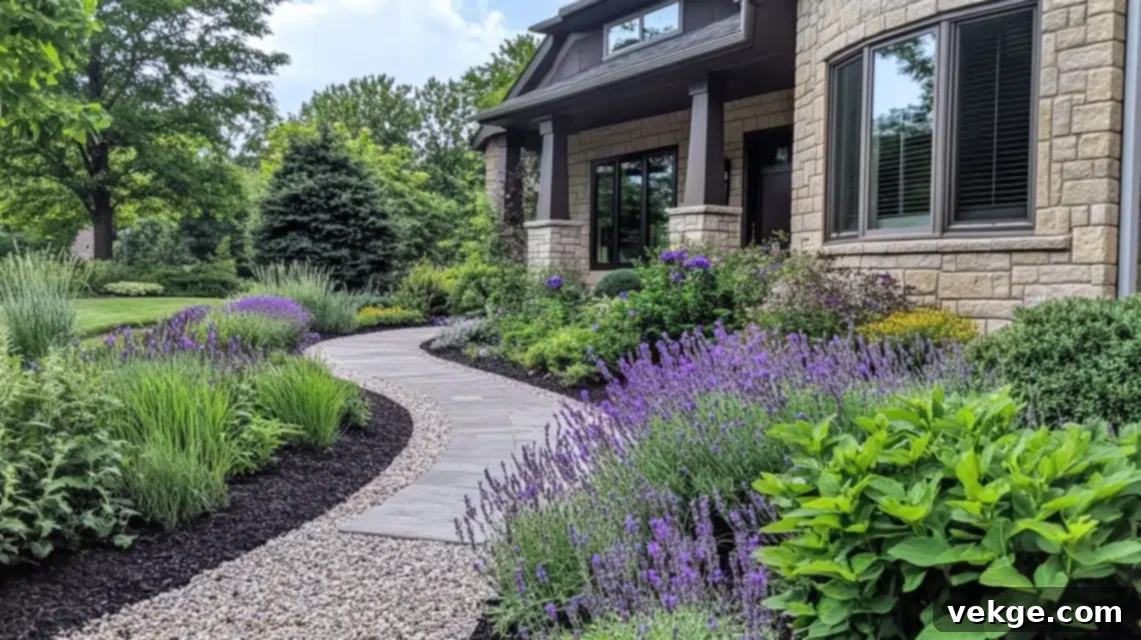
Your front yard serves as your home’s public face, making that first impression paramount. Here’s how to make it truly count:
- Pathways That Welcome: Create an inviting journey to your front door with gently curved walkways that intuitively guide visitors through your landscape. Mixing materials like flagstone with permeable gravel or using patterned concrete can add significant visual interest without overspending. A delightful touch is lining pathways with low-growing, fragrant plants such as lavender or creeping thyme, which release a lovely scent when brushed against.
- Entryway Gardens That Impress: Frame your entrance with balanced, symmetrical plantings that naturally draw the eye towards your front door. Consider layering plants of varying heights: perhaps classic boxwood shrubs as foundational anchors, backed by graceful ornamental grasses, and bordered with seasonal flowers for changing pops of color. This layering creates year-round structure and dynamic visual appeal.
- Low-Maintenance Options That Endure: Not everyone has endless hours for gardening, and that’s perfectly fine! Embrace low-maintenance strategies by incorporating native plants that naturally thrive in your local climate with minimal care requirements. My own front yard now features drought-resistant beauties like Russian sage and black-eyed Susans, offering stunning blooms and texture with very little need for intervention.
2. Maximizing Your Backyard for Outdoor Living
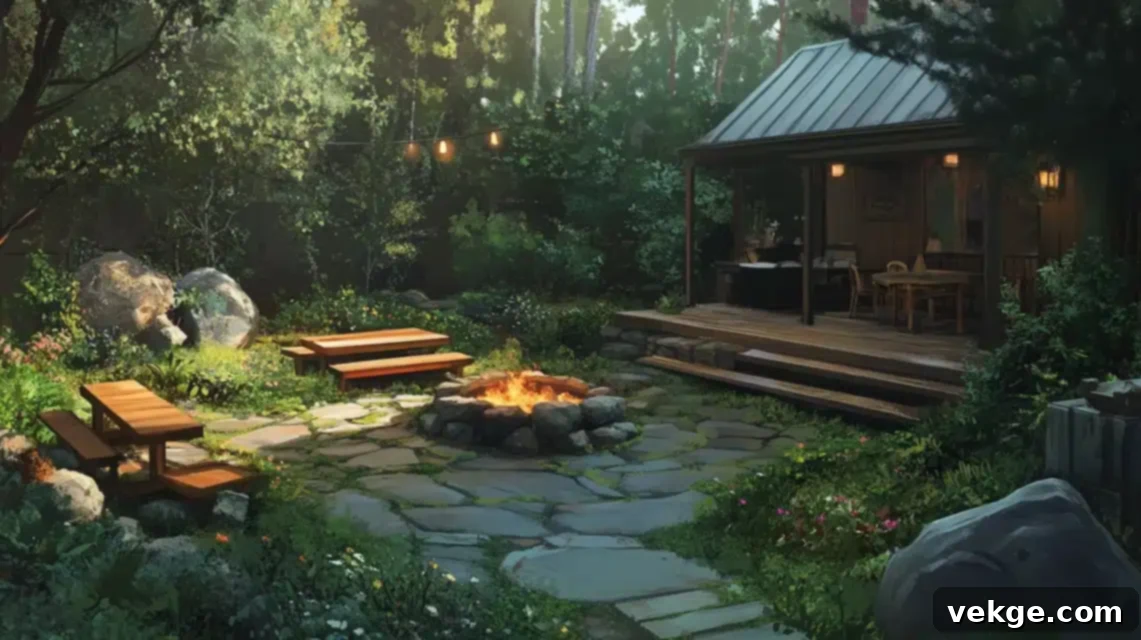
Your backyard is the ideal place to let your personality truly shine. This is where you can create zones for relaxation, entertainment, and family fun:
- Patios and Decks as Outdoor “Rooms”: Strategically break up your backyard into distinct areas for various activities. Envision a vibrant dining zone near the house, a cozy conversation area thoughtfully arranged around a fire pit, and perhaps a quiet reading nook tucked away in a shaded corner. I incorporated built-in benches into my own deck design, ingeniously doubling as storage for outdoor cushions and other essentials.
- Functional Outdoor Kitchens: Even a modest setup can profoundly change how you utilize your outdoor space. Begin with a high-quality grill and a convenient prep surface, then gradually add features like a mini-fridge or a pizza oven as your budget and needs evolve. My outdoor kitchen started as just a grill with a simple side table and gracefully evolved into a full cooking station over several years.
- Seamless Play Areas: Design kid-friendly spaces that remain aesthetically sophisticated. Natural play elements, such as climbing boulders or carefully placed stepping logs, blend beautifully with the landscape while providing endless opportunities for imaginative play. You can artfully conceal larger play equipment by creating strategically planted borders that offer both privacy and visual interest.
3. Ingenious Vertical and Small-Space Gardening Solutions

Limited space is not a limitation on possibilities; it’s an invitation for creativity:
- Embrace Vertical Solutions: Maximize every inch of vertical space with lush living walls, elegant hanging gardens, or beautifully trained climbing vines. I’ve witnessed breathtaking gardens flourish on urban balconies using simple grid systems attached to walls. Even the smallest patio can transform into a verdant oasis with intelligent vertical planning.
- Implement Compact, Multi-Functional Designs: In small spaces, every element should ideally serve at least two purposes – beauty and function. Consider built-in seating that cleverly conceals hidden storage, or raised garden beds that double as privacy screens. Smart design is about maximizing utility without sacrificing aesthetics.
Ultimately, the most successful landscape is one that seamlessly integrates with your lifestyle, reflects your personal taste, and matches your preferred level of maintenance. Begin by addressing the area that bothers you most, and gradually expand your efforts throughout your space. The true joy of landscaping is found in the journey of creation as much as in the beautiful destination.
Forward-Thinking Landscaping Trends to Embrace
The world of landscaping is continuously evolving, and I’ve observed some incredibly exciting shifts in how we approach our outdoor environments. These aren’t merely fleeting fads but significant advancements that enhance how we create and maintain beautiful, functional, and responsible landscapes.
1. The Rise of Sustainable Landscaping
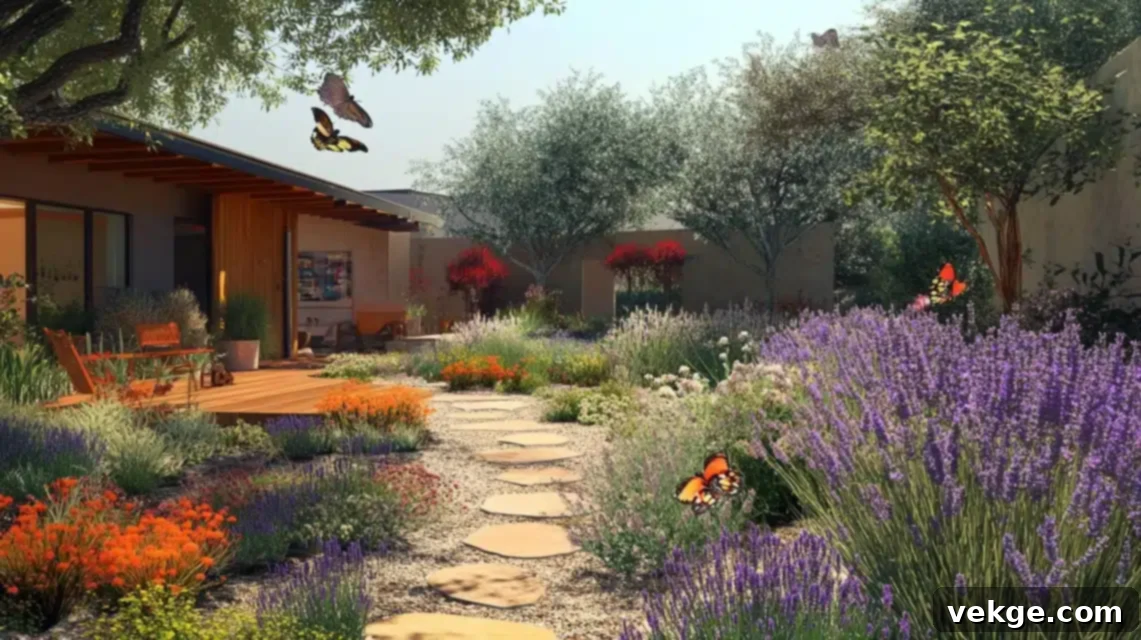
Sustainability is more than just a buzzword; it’s fundamentally reshaping our yards. I’ve personally transformed my own garden to be more eco-friendly, yielding remarkable results. By replacing thirsty turf with drought-resistant native plants like lavender, sage, and various native grasses, I’ve successfully reduced my water usage by half while cultivating a more vibrant, biodiverse, and low-maintenance landscape.
Rain gardens have become a particular passion of mine. These ingeniously designed shallow depressions, filled with deep-rooted native plants, effectively capture rainwater runoff. This not only prevents erosion but also naturally filters water before it enters waterways, significantly contributing to local ecosystem health. I strategically positioned mine to collect roof runoff, and it has blossomed into a stunning feature that attracts a diverse array of butterflies and birds, all while elegantly solving my drainage issues.
The materials we choose also play a crucial role. Permeable pavers, for example, allow rainwater to slowly seep into the ground, reducing surface runoff and replenishing groundwater. Recycled materials, such as composite decking, offer exceptional durability and beauty without depleting natural resources. Even your mulch selection can make a difference – I’ve transitioned to locally sourced wood chips, which not only reduce transportation emissions but also support community tree services.
2. The Beauty and Bounty of Edible Landscaping
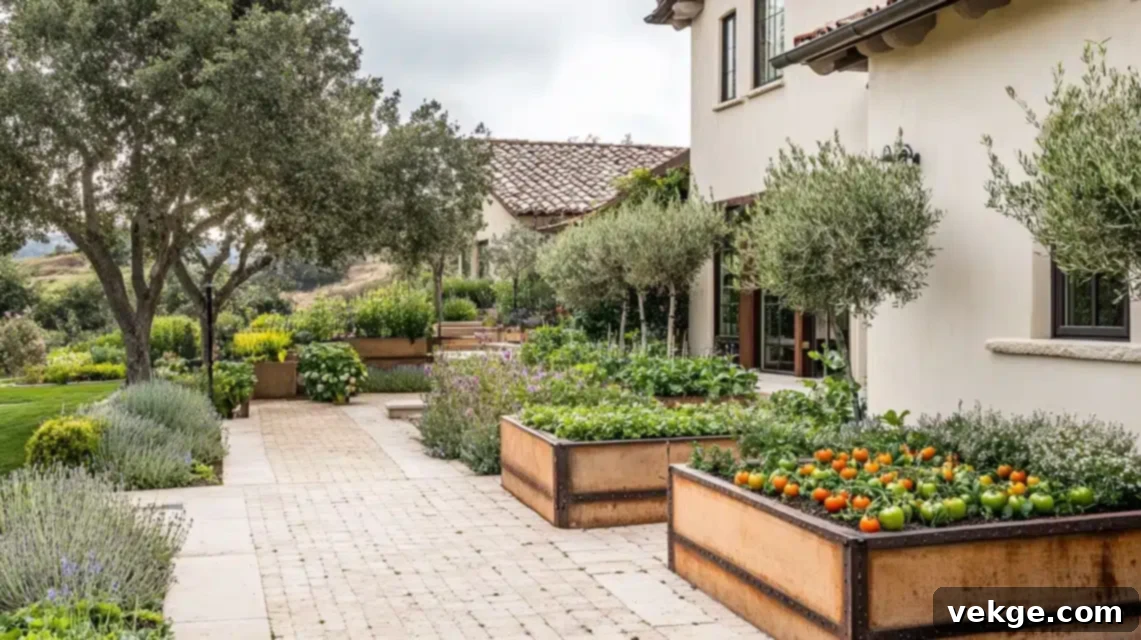
Who says a vegetable garden can’t be a stunning visual asset? I’ve discovered that artfully blending ornamental and edible plants creates landscapes that are both breathtakingly beautiful and remarkably functional. Imagine the delight of plucking fresh herbs from your front yard border or harvesting ripe tomatoes from decorative containers on your patio!
Fruit trees, particularly dwarf varieties, can serve as elegant focal points, providing beautiful seasonal blooms, cooling summer shade, and delicious fall harvests. I’ve planted dwarf apple trees along my driveway, and they offer stunning spring blossoms, summer shade, and abundant fruit. Underplanted with resilient thyme and chives, they are productive and visually appealing at multiple levels.
Herb gardens deserve special recognition for their incredible versatility in landscaping. I’ve used aromatic rosemary as a low, evergreen hedge, designed intricate geometric knot gardens with various sage varieties, and allowed creeping thyme to soften the edges of my pathways. The undeniable bonus? Fresh, culinary-grade herbs are always just steps away from my kitchen door.
3. The Innovation of Smart Landscaping Solutions
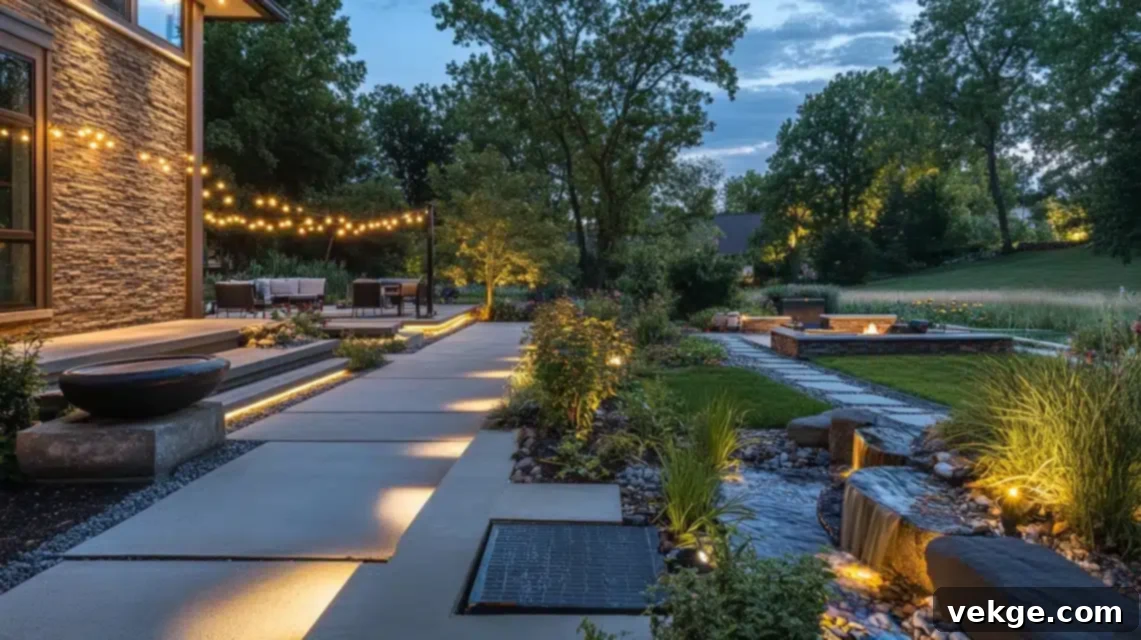
Technology is revolutionizing how we effortlessly care for our outdoor spaces. Smart irrigation systems have been a true game-changer in my garden. My system intelligently adjusts watering schedules based on real-time weather forecasts and precise soil moisture levels, ensuring plants receive exactly what they need while conserving precious water. This system paid for itself through water savings within just two years.
Solar lighting has also advanced significantly. Today’s options include sophisticated pathway lights that automatically adjust their brightness based on ambient light levels, motion-sensor security lights, and even charming decorative string lights that create a magical evening ambiance without adding a cent to your electric bill.
Some of my favorite smart additions include:
- Weather-Responsive Sprinkler Controls: These systems intelligently skip watering cycles when rain is forecast, preventing overwatering and waste.
- App-Controlled LED Landscape Lighting: Program different lighting schemes for various occasions directly from your smartphone, creating dynamic outdoor moods.
- Soil Moisture Sensors: Receive alerts directly to your phone when specific plants or garden zones require water, eliminating guesswork.
- Solar-Powered Water Features: Enjoy the soothing sounds of moving water without the need for complex electrical wiring or increased utility costs.
The most exciting aspect of these trends is their synergistic potential. My edible garden benefits from smart irrigation, sustainable practices guide every plant choice, and solar lighting beautifully illuminates it all. The result is a landscape that is not only stunning but also remarkably productive, efficient, and forward-thinking.
Remember, integrating these trends doesn’t necessitate a complete overhaul of your existing space. Start with one element that genuinely excites you – perhaps a small herb garden, a single smart irrigation feature, or a new native plant bed – and gradually build from there. The ultimate goal is to cultivate a landscape that works in harmony with nature, seamlessly meeting your needs and reflecting your unique style preferences.
Deep Dive into Eco-Friendly Landscape Design Principles
Beyond general trends, specific eco-friendly design principles are guiding the creation of truly sustainable and resilient outdoor spaces. These approaches prioritize ecological health and long-term viability.
1. Cultivating Native Plant Communities
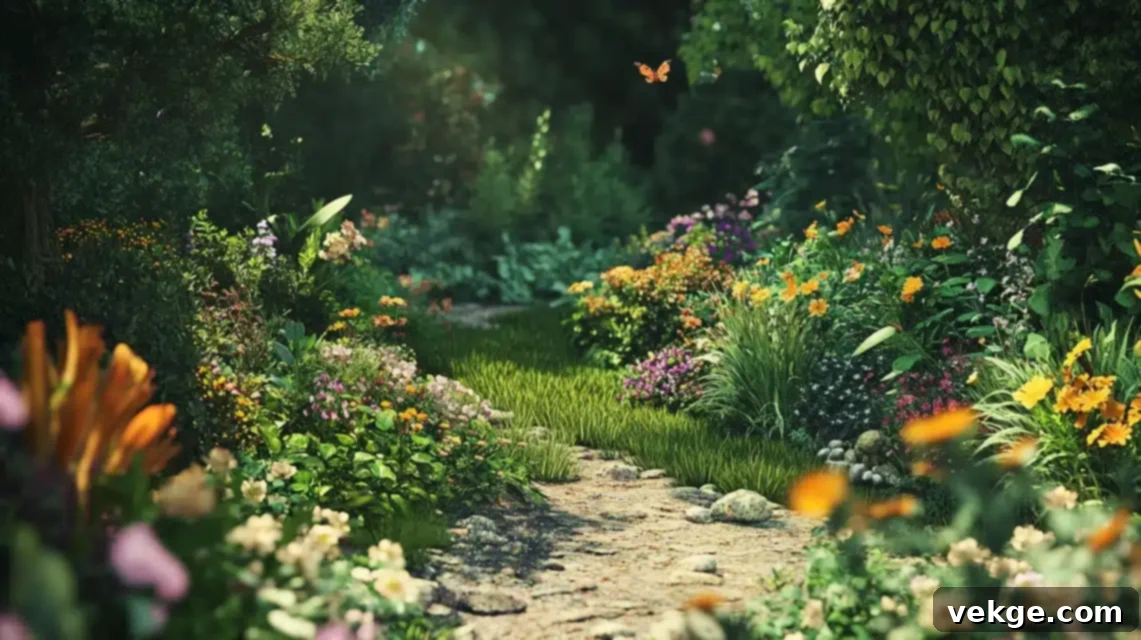
Designing landscapes that operate in seamless harmony with nature is not only environmentally responsible but also inherently beautiful and remarkably low-maintenance. I’ve personally transformed my garden into a vibrant haven for local wildlife by carefully integrating native plants that naturally thrive in my specific region. The key lies in thinking in terms of interconnected plant communities rather than isolated specimens. By grouping plants that naturally grow together, you effectively create self-sustaining ecosystems that foster local biodiversity while requiring minimal human intervention, reducing the need for excessive watering, fertilizing, or pest control.
2. Innovative Water Conservation Solutions
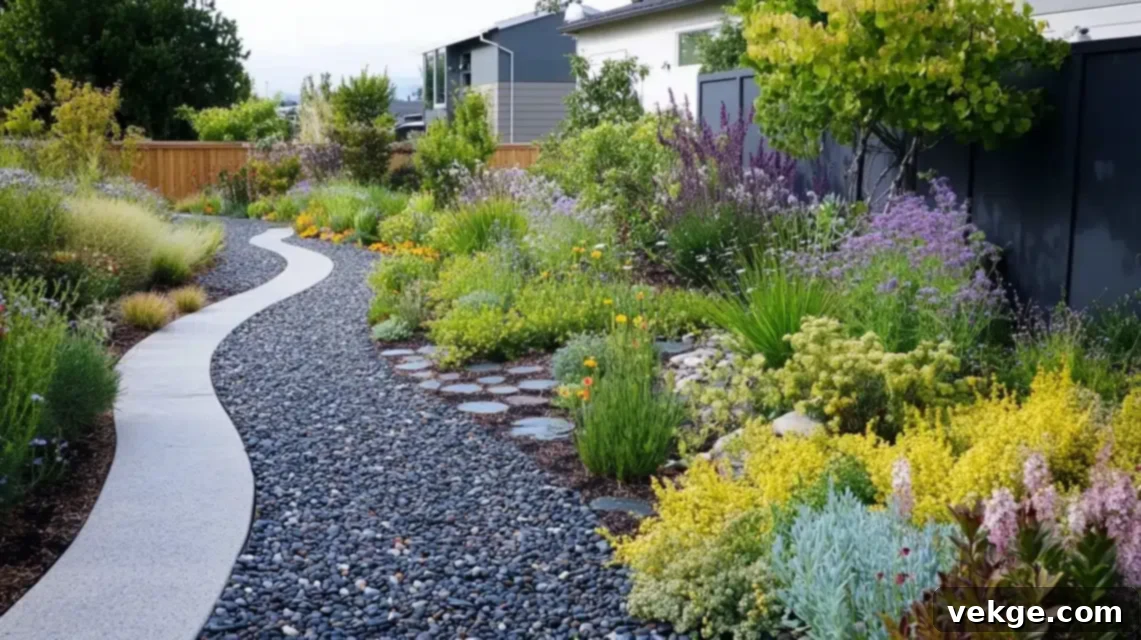
Water-wise landscaping has evolved significantly beyond basic xeriscaping. Today’s cutting-edge designs seamlessly integrate clever solutions like functional rain gardens and elegant bioswales, transforming essential water management into attractive and integral landscape features. In my own yard, I implemented a rain garden that efficiently captures roof runoff, creating a lush, vibrant oasis that requires virtually no supplemental watering. Furthermore, choosing permeable paving materials for driveways and pathways allows rainwater to naturally seep into the ground, reducing problematic runoff while adding visual texture and interest.
3. Embracing Eco-Friendly Materials in Design
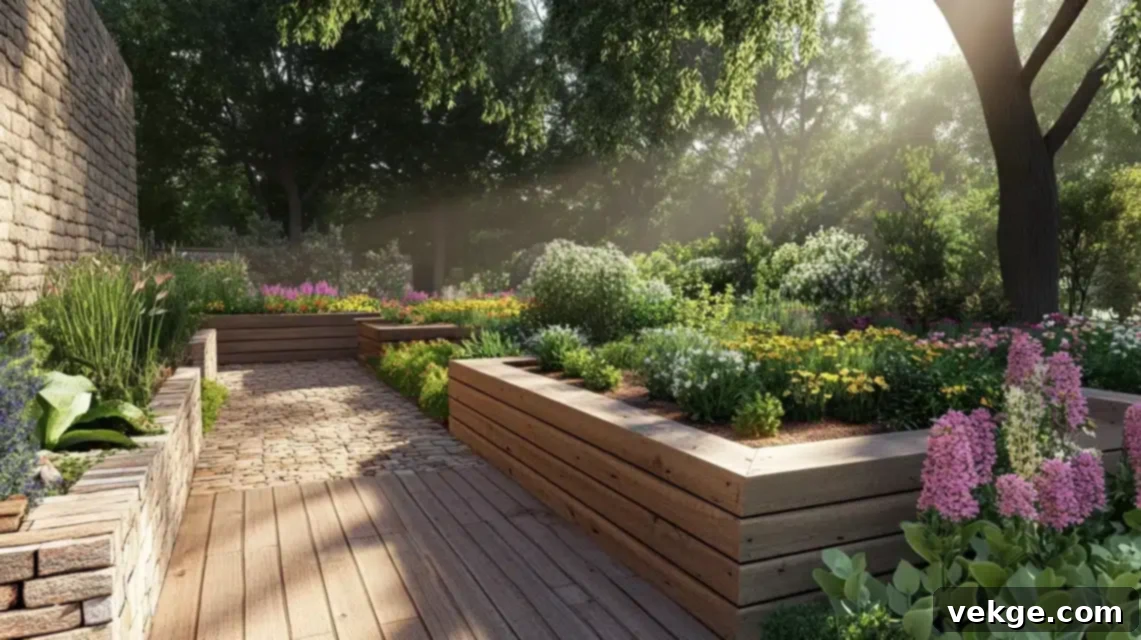
The materials we select for our landscapes have a profound environmental impact. I’ve discovered incredibly creative ways to incorporate recycled and sustainably sourced materials into my designs. For instance, old bricks can be repurposed into charming and durable pathway borders, reclaimed wood can be transformed into robust raised garden beds, and locally sourced stone significantly reduces transportation emissions. Sustainable composite decking offers the elegant aesthetic of wood without the ecological cost of harvesting trees, while chemical-free lumber alternatives provide safe and responsible options for structures located near edible gardens.
4. Designing with Wildlife-Friendly Features
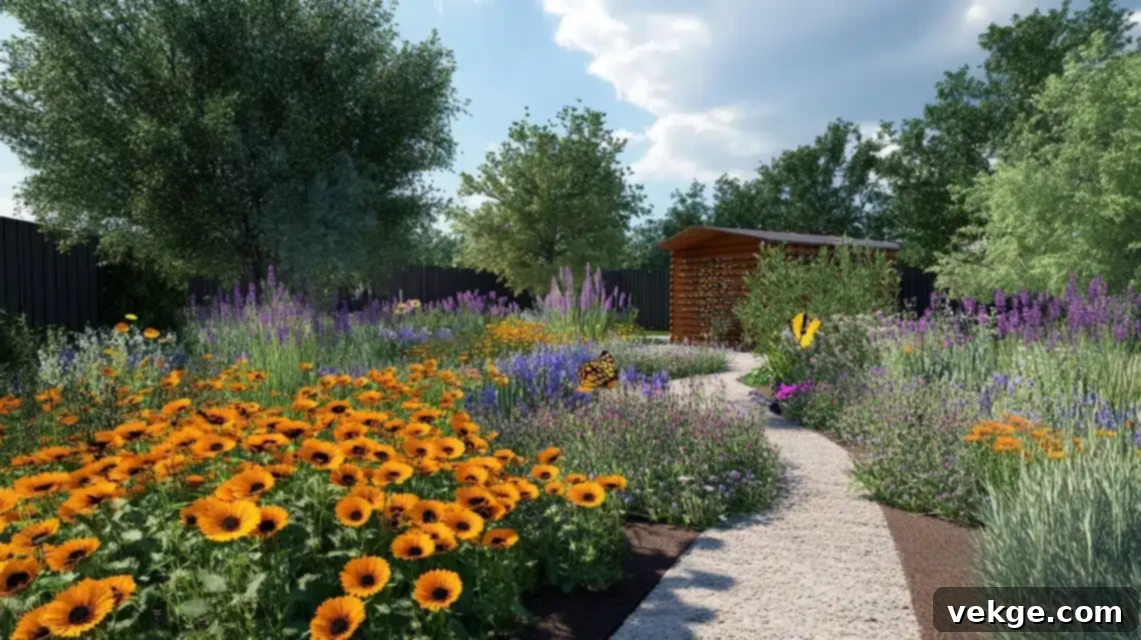
Cultivating a habitat that supports local wildlife adds immense ecological value and provides endless, captivating entertainment to your landscape. My pollinator garden, for example, absolutely buzzes with activity from bees, butterflies, and other beneficial insects from early spring through late fall, thanks to careful succession planting. Simple additions like inviting insect hotels and refreshing bird baths instantly transform your garden into a vital sanctuary for beneficial creatures. I’ve even begun leaving some seed heads standing through the winter months, providing crucial natural food sources for birds when other options are scarce.
5. Implementing Sustainable Garden Practices
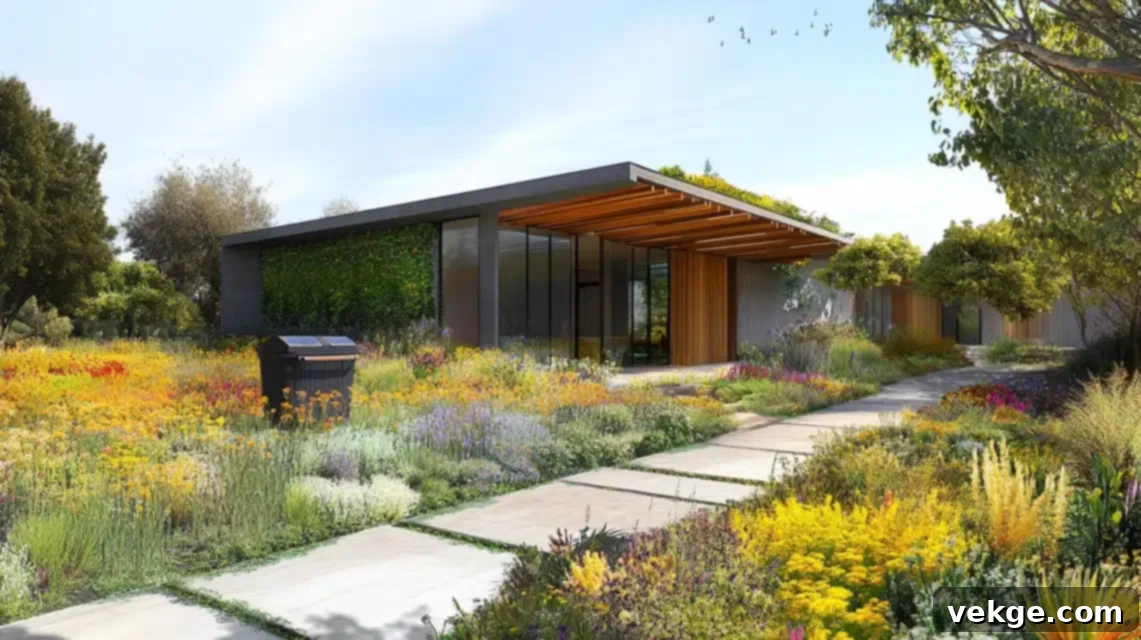
Modern eco-friendly landscaping extends well beyond just plant selection; it encompasses a holistic embrace of sustainable maintenance practices. Thoughtfully designed composting stations can be beautifully integrated into garden layouts, transforming organic waste into nutrient-rich soil amendments. Solar-powered lighting significantly reduces energy consumption. Furthermore, innovative features like living walls and green roofs not only offer stunning visual appeal but also provide crucial environmental benefits, including improved air quality, enhanced insulation, and a significant reduction in the urban heat island effect. I’ve personally designated several “no-mow” zones in my yard, allowing natural habitats to flourish while simultaneously reducing maintenance time and emissions from lawn equipment.
6. Seamless Food Production Integration (Edible Landscaping)
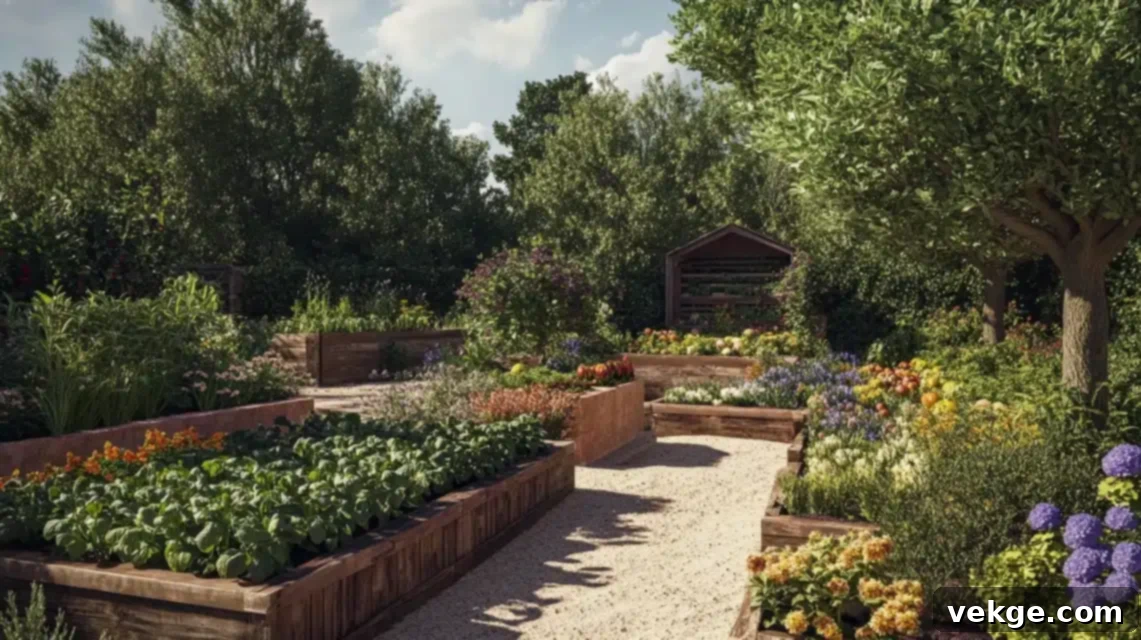
One of the most exciting and rewarding trends in landscape design is the creative integration of food production directly into ornamental landscapes. By artfully mixing vegetables, fruits, and herbs with traditional landscaping plants, you can cultivate beautiful, highly productive spaces that benefit both people and local wildlife. I’ve successfully incorporated dwarf fruit trees as striking focal points, used vibrant herbs as fragrant border plants, and even created a delicious edible hedge using blueberry bushes. The tangible result is a landscape that is not only visually stunning and ecologically sustainable but also wonderfully rewarding with its fresh, homegrown bounty.
Remember, making the transition to eco-friendly landscaping doesn’t have to be an overnight transformation. Begin with one manageable area of your yard, and gradually expand your sustainable practices over time. The multitude of rewards—from reduced maintenance costs and lower water bills to increased wildlife activity and a deeper connection with nature—makes the effort incredibly worthwhile.
Conclusion: Cultivating Your Home-Hearted Landscape
Landscaping is far more than simply enhancing your yard; it’s a profound opportunity to extend the inherent warmth, comfort, and unique personality of your home to the great outdoors. Much like a thoughtfully designed interior, a well-planned landscape crafts spaces that are highly functional, aesthetically beautiful, and truly reflective of you. Whether your vision involves a welcoming front yard that captivates passersby, a serene and relaxing backyard retreat, or a clever, creative solution for a compact urban space, landscaping empowers you to bring your deepest aspirations to vibrant life.
At Home-Hearted Landscaping, our core philosophy is that your outdoor spaces should feel as inviting, personal, and beloved as your favorite living room. By harmoniously blending thoughtful design principles, smart planning strategies, and a touch of genuine creativity, you possess the power to transform your yard into a living reflection of your home’s distinct style and profound heart.
Are you ready to embark on the exciting journey of transforming your outdoor space? Whether you choose the fulfilling path of DIY or opt to collaborate with experienced professionals, remember this: every single step you take towards cultivating a beautiful, functional landscape is a meaningful stride toward creating a home you genuinely adore, both inside and out.
Frequently Asked Questions About Eco-Friendly Landscaping
What Exactly Is Eco-Friendly Landscaping?
Eco-friendly landscaping, often referred to as sustainable landscaping, centers on creating outdoor spaces that actively conserve water, robustly support local wildlife and biodiversity, and significantly minimize overall environmental impact. This holistic approach involves key practices such as utilizing native plants, drastically reducing water usage through efficient irrigation, completely eliminating harmful chemical pesticides and fertilizers, and thoughtfully incorporating sustainable materials and environmentally sound maintenance practices into every aspect of design and care.
Is Eco-Friendly Landscaping More Expensive to Implement?
While the initial outlay for certain eco-friendly elements, such as installing a sophisticated smart irrigation system or sourcing specific sustainable materials, might appear slightly higher upfront, eco-friendly landscapes are almost universally more cost-effective in the long run. You will experience substantial savings on your water bills due to reduced consumption, significantly lower maintenance costs as native species require less intensive care, and decreased expenses on plant replacements since native varieties are perfectly adapted to local environmental conditions. Moreover, many sustainable practices, like composting your own organic waste and creatively repurposing recycled materials, can actively reduce your overall project costs.
Can I Create an Eco-Friendly Landscape if I Have a Small Yard?
Absolutely! Small spaces are, in fact, ideal canvases for innovative eco-friendly designs. They are perfectly suited for vibrant vertical gardens, charming container plantings featuring native species, and compact yet highly effective rain gardens. Even a tiny urban balcony can be transformed into a thriving pollinator haven with careful plant selection and clever design. The key is to maximize every available inch of space through ingenious techniques such as vertical growing systems, multi-functional design elements, and thoughtful plant layering.
How Do I Start Transitioning to An Eco-Friendly Landscape?
The best way to begin is to start small and plan meticulously. Consider the following initial steps:
- Conducting a comprehensive soil test to understand your unique soil composition.
- Identifying specific areas in your yard where existing plants can be replaced with beneficial native species.
- Installing a simple rain barrel or creating a small, impactful rain garden to manage stormwater.
- Transitioning to organic and chemical-free maintenance practices for your lawn and garden beds.
- Adding just a few pollinator-friendly plants to immediately attract beneficial insects.
Will an Eco-Friendly Landscape Attract Unwanted Wildlife?
While your garden will undoubtedly attract more desirable wildlife, such as a greater diversity of birds, butterflies, and beneficial insects, proper design and planning can effectively discourage unwanted creatures. Strategic plant placement, the thoughtful incorporation of appropriate fencing or barriers, and a thorough understanding of local wildlife habits can help you strike a harmonious balance, creating a thriving natural space that works beautifully for your specific environment and preferences.
